A well designed pool shell will be water tight (i.e. have no water leaks) with an applied finish that protects the shell from chemicals in the pool’s water.
A pool shell’s major components include:
-
Pool Floor
Most floors for large pools (25 metres or longer) are constructed using steel bar reinforced concrete, which is cast in-situ (i.e. not sprayed). This method of construction provides an opportunity for quality control of the following:
- Accurate positioning of the steel reinforcement
- Vibration of the concrete during placement to minimise any risk of concrete voids.
- Checking of concrete floor thickness during placement.
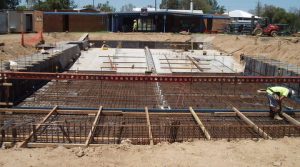
-
Pool Wall
The walls of large swimming pools are almost always constructed using concrete. Concrete walls can be either formed and cast in-situ, pre-cast or sprayed. Formed concrete walls offer the cheapest whole-of-life cost alternative.
Formed Concrete Walls
Concrete walls have traditionally been constructed on site between panels of vertical formwork to allow accurate positioning of steel reinforcement and placement of concrete which can be well compacted. Pools that are well designed and well constructed, with formed concrete walls, can be expected to have a useful life of approximately 50 years, requiring only minor maintenance.
Precast Concrete Walls
Factory manufactured, precast concrete walls are at first glance an attractive proposition for large swimming pools, particularly those constructed in remote locations.
Unfortunately precast concrete walls, when used to construct swimming pools, have the following limitations:-
- Difficult to position accurately
- Difficult to provide a long-term water-tight seal between the precast wall panels.
- Difficult to achieve load transfer between precast wall panels.
In view of the above, precast concrete panels should not be used to construct large swimming pools. Our reports on several large pools, constructed with precast concrete walls, supports this advice.
Sprayed Concrete Walls
Sprayed concrete is concrete conveyed through a hose and pneumatically projected at high velocity onto a surface, as a construction technique.
Pools with sprayed concrete walls are typically designed with a single layer of steel reinforcement (e.g. 12mm diameter steel bars at between 200mm to 300mm centres) nominated to be positioned at the middle of a 150mm thick wall. It is very difficult to construct joints that don’t leak in sprayed concrete pools. As a result, sprayed concrete pools are often built without any joints. As sprayed pools increase in size, a lack of joints becomes more problematic (i.e. concrete shrinkage cracks open wider and the risk of cold joints in the concrete increases).
Other problems associated with sprayed concrete pool walls include the following:
- Wall strength is limited when a single layer of steel reinforcement is located in the middle of the wall. Formed concrete pool walls typically have 2 layers of steel reinforcement, making them significantly stronger.
- There is no way of accurately controlling the final position of steel reinforcement in the concrete wall’s cross-section.
- The inability to reliably control concrete compaction often leads to voids in the concrete.
- The rear of sprayed concrete pool walls usually cannot be inspected for water leaks, when the pool is filled with water to confirm it is water-tight
Conclusions regarding Sprayed Concrete Walls
Pools with sprayed concrete walls are very easy to design (e.g. typically 150mm thick concrete walls with 12mm diameter steel bar reinforcement at 200 to 300mm centres located at the centre of the wall) and are therefore popular with some engineers.
There is very limited opportunity for construction quality control of sprayed concrete pool walls. The following are either difficult or impossible to ensure:
- wall concrete thickness
- final location of steel reinforcement in the wall
- incidence of concrete voids
- whether the wall has been constructed water tight.
Sprayed concrete pool walls must be rendered before they can be tiled, introducing another material that if not correctly applied could fail.
Expect pools with sprayed concrete walls to have a useful life of significantly less than 50 years and cost significantly more to maintain than a pool constructed with formed concrete walls.
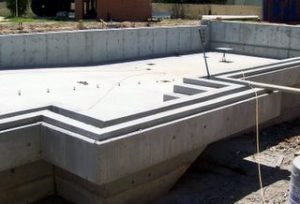
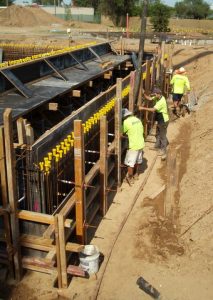
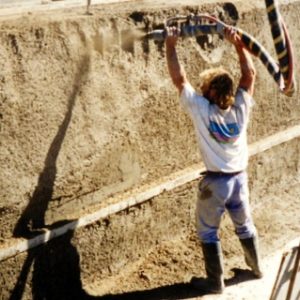
-
Pool Construction Joints
Large pools are often broken into several concrete pours, in an effort to prevent concrete shrinkage cracks opening too wide. Construction joints are detailed between concrete pours.
Pool construction joints, if not well positioned, well detailed and well constructed, are a common cause of pool water loss. Waterstops are cast in construction joints in an effort to make the joint water tight. It is also important to understand that mastic used to seal a construction joint is only intended to keep dirt out of the joint, not to make the joint watertight.
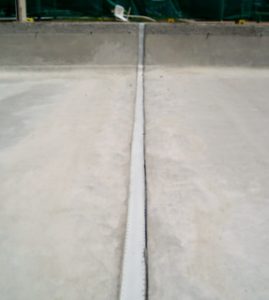
Repair of failed pool construction joint
-
Applied Pool Finishes
Tiles
Tiles arguably provide the best quality of any finish commonly applied to the concrete shells of municipal and school swimming pools.
If tiles are well chosen, well detailed and correctly installed they can provide the cheapest whole life cost for an applied finish to a pool that has a design life of 50 years. However if tiles are not well chosen and not well detailed and not correctly installed, they can provide the most expensive whole life cost for the finish of any pool. A well tiled pool always looks attractive, and is easy to keep clean, enhancing pool water quality.
Cement Based Renders
Cement based finishes are a mixture of sand, cement and other additives. They provide a rougher finish than tiles.
Cement based, applied pool finishes have considerable limitations, including the following:-
- The pool cannot be emptied for maintenance without considerably increasing the risk of some areas of the applied finish delaminating from the pool’s concrete shell. When the applied finish delaminates (i.e. detaches and is “drummy” when tapped), growths of algae and bacteria develop unnoticed in the void created, compromising pool water quality.
- The cementitous material provides an ideal rough surface for the attachment of algae. The use of granulated chlorine and brooming to remove the algae make the surface even rougher. This cycle of algae growth and removal makes algae removal more difficult each time. It is only a matter of time until the applied finish must be removed and replaced. This is an expensive exercise.
- Cement based renders crack due to differential movement between the render and the pool’s concrete shell. Render beside cracks often becomes drummy allowing the growth of algae and bacteria in the void created.
PVC Liners
PVC liners are typically approximately 1mm thick and therefore very susceptible to damage, particularly from vandalism. PVC liners are usually used in pools that have not been designed to be water-tight. As a result, when the liner is damaged, the pool is obviously no longer water-tight. For these reasons, PVC liners are seldom used as a finish for municipal and school swimming pools.
Paint
Chlorinated pool water is an aggressive environment for any painted surface. As a result, painted pools require regular repainting. Eventually numerous layers of paint make repainting an ineffective solution, necessitating removal of paint back to bare concrete. The paint removal process often leaves the concrete too rough for repainting. The only solution is to skim coat the concrete before repainting.
Chlorinated Rubber Based Paints
For a long time, chlorinated rubber based paints have been used to paint the internal surfaces of large concrete pools. At best, chlorinated rubber based paints only last a couple of years before they require repainting. Poor surface preparation or incorrect application of chlorinated rubber based paints often results in the paint lasting only a few months. Painted pool surfaces in poor condition make a pool unattractive to bathers. Oxidation of chlorinated rubber based paints creates a loose powder on the painted surface. When the surface is rubbed, the oxide becomes suspended in the pool’s water, compromising pool water quality.
Epoxy Paints
More recently, epoxy paints have been used, instead of chlorinated rubber based paints, to paint pools. Epoxy paints, if correctly applied, can provide a painted pool finish with a longer life than chlorinated rubber based paints. Epoxy paints require careful application to achieve a good bond to the concrete substrate and between layers of epoxy.
